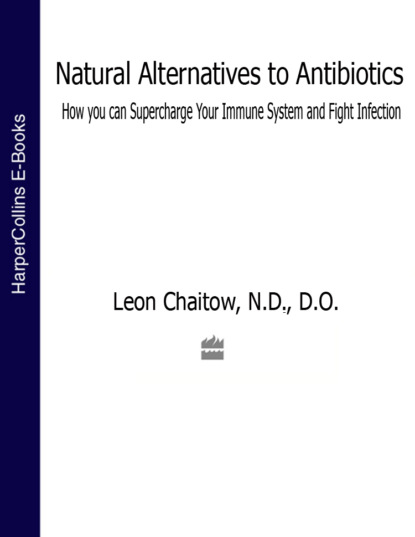По всем вопросам обращайтесь на: info@litportal.ru
(©) 2003-2024.
✖
Natural Alternatives to Antibiotics: How you can Supercharge Your Immune System and Fight Infection
Автор
Год написания книги
2019
Настройки чтения
Размер шрифта
Высота строк
Поля
If your child has otitis it is very likely that antibiotics will be prescribed for a course which could run for between 3 and 10 days, depending upon what the doctor believes and has read of current research. As we will see, no antibiotics at all is usually the best choice, and if any are given 3 days is as good as 10. Along with the antibiotics, decongestant and painkilling medication will also usually be prescribed.
In the normal course of events, relief from the pain of the ear infection will be noticed by the distressed child within a matter of hours. And the grateful parent is likely to think – ‘how wonderful, how good that the pain and distress is easing, bless the antibiotics’ … and yet …
As for back as the early 1970s doctors at the University of Copenhagen were recognizing that the repeated use of antibiotics to treat children’s ear infections led to an increased likelihood of:
more ear infection and therefore more antibiotics, and
a greater chance of surgery ultimately being needed.
They decided that such problems should be treated in other ways.
They claimed, after much research that, ‘88 per cent of patients [with otitis] never need antibiotics.’ They had found that the frequency of recurrence of otitis media in the many children with otitis whom they were treating and who were not receiving antibiotics was low compared with those who were receiving antibiotics, who commonly had another ear infection within a month or so of the end of their course of antibiotics.
More recent research has validated the Danish viewpoint, with serious doubts being raised as to the usefulness (and wisdom) of antibiotic care of otitis.
These doubts have been regularly expressed in major medical journals such as the British Medical Journal, the Lancet and the Journal of the American Medical Association, where we might expect some notice would have been taken by those responsible for the health of our children.
The American researchers stated, ‘Recurrence rates were significantly higher in the antibiotic treated group [of children] than in the placebo group [those receiving dummy medicines].’ In fact, the children receiving antibiotics were between 200 and 600 percent more likely to have recurrence of the ear infection compared with children receiving no antibiotic treatment at all – whose own immune systems were dealing with the infections.
In 1981 a study was performed involving over 170 children with otitis. All the patients were given the usual painkilling and decongestant medicines; some were then also prescribed antibiotics, others also had both antibiotics and surgery (myringotomy – where the ear drum is punctured to release fluids which are pressing on it), while others had this form of surgery but were not prescribed antibiotics.
THE RESULTS?
There was no difference at all between any of the groups of children as far as
the rate of recovery from pain
how quickly temperature normalized
how soon ear discharge stopped
the appearance of the inner ear
the rate of recurrence of infection.
There was no difference at all whether antibiotics were given or not!
The same researchers looked at the problem again in 1985, this time involving nearly 5,000 children with otitis.
This time they found that 90 percent of the children recovered, without any problems, without antibiotics, only having painkillers and decongestants to ease the symptoms while they recovered on their own.
So we see that as long ago as the late seventies and early eighties reputable scientific evidence existed showing that children who had antibiotics for middle ear infections usually did not benefit from them and were more likely to get another infection soon, compared with children not given antibiotics.
SUMMARY
Treating otitis with antibiotics seems to increase the chances of further infection by between 200 and 600 percent.
Treating otitis with antibiotics seems to increase enormously the chances of surgery being required.
Around 90 percent of children get better just as fast, with no significant differences in speed of relief of pain, temperature or other symptoms – whether they have antibiotics or not in treating their otitis.
Treating otitis media with antibiotics devastates the friendly, useful internal flora with potentially harmful bacteria and yeasts likely to replace them.
Treating acute otitis with antibiotics is just as ‘effective’ whether it lasts for 3 days or 10 days – and it is not hard to know which would do less harm to the friendly bacteria.
Antibiotic Misuse
After confirming their belief that bacteria possess remarkable abilities to mutate and defend themselves, something we can do little about at this stage, Professor French and Emeritus Professor Phillips of the Department of Microbiology at St. Thomas’s Hospital, London, are scathing in their comments as to factors we could do something about, including the wrong use of antibiotics:
Antibiotic misuse is common. Studies have shown that up to 70 per cent of treatment courses are ‘unnecessary’ or ‘inappropriate’; Therapy is often unnecessarily prolonged … physicians are often poorly informed about the use of antibiotics and may obtain most of their information from pharmaceutical companies.
They also condemn the widespread and apparently haphazard use of antibiotics in animal farming as a cause of the spread of resistance.
Aside from these elements of overuse, misuse, abuse of (and sometimes failure to use) antibiotics, the particular situations which occur in hospitals are a key factor in the evolution of resistant strains.
What we are seeing is an approach to treating infection which actually makes greater infection and general disease more likely. This approach calls into question the ability of those responsible for our health to think more than a few days’ hence, since the prospects it produces of untreatable superinfections becoming rampant in the community, as well as in hospitals, is too frightening to contemplate. And, being too frightening to contemplate, it is not thought about – it is left as something which will be dealt with when it happens.
Unfortunately for the general population, it is already happening.
It is not as though warning bells have not been ringing for years:
Books such as Marc Lappe’s When Antibiotics Fail were met when first published in the mid-1980s with glowing reviews in the major medical and lay press, yet nothing appears to have been done to stem the tide of misuse and overuse of antibiotics by doctors.
Geoffrey Cannon’s major book Superbug, diligently researched and referenced, first appeared in 1995 and was reviewed in the popular press with words such as ‘It delivers a message that will haunt the average pill-swallower for life’ (Daily Express) and was welcomed by leading microbiologists. It does not (as yet) seem to have made much impact on medical prescribing habits of antibiotics, despite showing clearly just how serious the crisis is.
According to the British Medical Association’s New Guide to Medicines and Drugs (1995), one prescription out of six is for antibiotics, and it is estimated by researchers such as Lappe that most of these are inappropriate and/or excessive, producing the perfect situation to encourage increased resistance.
Lappe discusses the frightening degree of resistance to antibiotics of Neisseria gonorrhoea, the organism responsible for gonorrhea, and makes the point that between 1986 and 1988 there was a 60 percent increase in resistance to penicillin, and that to cover this change tetracycline was introduced. This, too, quickly produced resistant strains, leading to the introduction of spectinomycin, which by 1988 had resulted in the first resistant strains (to it) being discovered. As a further twist in this never-ending game of catch-up, some hospital groups now use ever more powerful and expensive anti-gonorrhea cephalosporin antibiotics, such as ceftriaxone.
As Lappe sees it,
This ‘new’ (and expensive) therapeutic fix to a social problem may yet meet a similar fate. Unless antibiotic uses are coupled with sound health education about the hygienic measures needed to control the epidemic, no success in abating this epidemic is likely. Just such success has been charted in the gay community, where the widespread practice of ‘safe sex’ has led to an abatement of both AIDS and gonorrhoea in California.
This important insight of Lappe’s needs emphasis:
Unless causes are dealt with, antibiotics will fail in the long run – even if they are used sensibly.
If problems emerge from a lack of hygiene, then the ‘cure’ lies in better hygiene.
If causes lie in poor nutrition, then ‘cure’ lies in better nutrition.
If causes lie in poverty and social problems, then political and social action is needed – not the pumping of ever more antibiotics (or whatever) into the already sick population, an approach which simply masks the symptoms, ignores the causes and sets the scene for the infection explosion many now anticipate.
In the short term it makes sense to use antibiotics to save lives. But the antibiotics must be used sensibly, cautiously, appropriately and not haphazardly and excessively, as they are now.
Even when used correctly and appropriately (and remember, please, that Professors French and Phillips – quoted earlier in this chapter – believe that over 70 percent of antibiotics are ‘wrongly’ prescribed), serious long-term changes occur in our internal ecology when most antibiotics are taken, involving the friendly bacteria which keep us alive. This makes antibiotic use a potential health hazard even when prescribed and taken correctly and appropriately.
In the long term, underlying causes of ill-health have to be addressed both on a large scale by health authorities and government, and on an individual level by an acceptance of responsibility – by a recognition that each of us has the power to decide whether to maintain hygienic habits in our lives. Each of us can, if we wish, undertake to incorporate health-enhancing practices, rather than disease-causing ones, into our daily lives.









